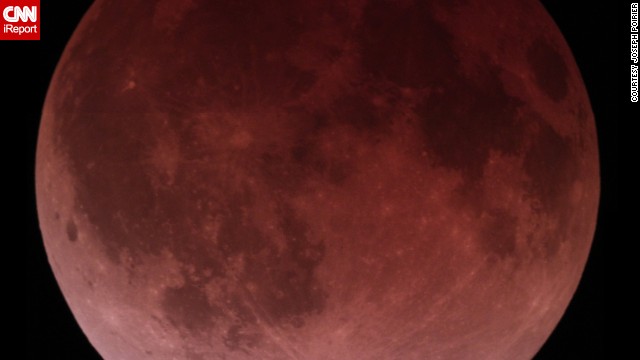 CNN iReporter Dan Huntley mostly does landscape and travel photography, but he turned his camera to the sky for this shot of the "blood moon" over Dallas on Tuesday, April 15. Huntley has seen eclipses before but not a blood moon. He described it as being "quite amazing."
CNN iReporter Dan Huntley mostly does landscape and travel photography, but he turned his camera to the sky for this shot of the "blood moon" over Dallas on Tuesday, April 15. Huntley has seen eclipses before but not a blood moon. He described it as being "quite amazing."  Jeffrey Root shot this photo of the April 15 blood moon through a telescope in Salt Lake City.
Jeffrey Root shot this photo of the April 15 blood moon through a telescope in Salt Lake City.  The April 15 blood moon passes over Port Orange, Florida, in this time-lapse image from Kenneth Ngyuwai.
The April 15 blood moon passes over Port Orange, Florida, in this time-lapse image from Kenneth Ngyuwai.  High school sophomore Ahan Malhotra and his dad captured this composite image of the blood moon over Miami early April 15. "My dad and I have been planning to view this for many months, and it was truly a breathtaking experience," said Malhotra, an astronomy enthusiast who likes to photograph "mostly galaxies and nebulae."
High school sophomore Ahan Malhotra and his dad captured this composite image of the blood moon over Miami early April 15. "My dad and I have been planning to view this for many months, and it was truly a breathtaking experience," said Malhotra, an astronomy enthusiast who likes to photograph "mostly galaxies and nebulae."  Joseph Poirier shot this photo of the blood moon in Austin, Texas, with his telescope. He says he woke up his 10-year-old son, who had never seen a lunar eclipse before.
Joseph Poirier shot this photo of the blood moon in Austin, Texas, with his telescope. He says he woke up his 10-year-old son, who had never seen a lunar eclipse before.  Kevin Cavallin snapped this photo in Ames, Iowa, at 2:45 a.m. local time. He captured it without a telescope, which was a challenge. "As expected, had a difficult time getting the exposure without bad motion blur," said Cavallin, a laboratory technologist who enjoys photographing wildlife.
Kevin Cavallin snapped this photo in Ames, Iowa, at 2:45 a.m. local time. He captured it without a telescope, which was a challenge. "As expected, had a difficult time getting the exposure without bad motion blur," said Cavallin, a laboratory technologist who enjoys photographing wildlife.  Jason Asselin of East Kingsford, Michigan, says he nearly missed the total lunar eclipse. "I had fallen asleep on the couch and woke up just as the full eclipse had started," he said.
Jason Asselin of East Kingsford, Michigan, says he nearly missed the total lunar eclipse. "I had fallen asleep on the couch and woke up just as the full eclipse had started," he said.
- The moon turns a copper reddish color before dawn
- Unlike solar eclipses, lunar eclipses are safe to view with the naked eye
- Hundreds across North and South America shared their photos
- Share your "blood moon" images with CNN iReport
(CNN) -- Stargazers glimpsed a rare treat as a "blood moon" crossed the Earth's shadow Tuesday.
The moon took on a devilish glow as it appeared in different phases from 2 to 4 a.m. ET.
Hundreds of people from North and South America, where the blood moon was most visible, shared their images of the lunar spectacle with CNN iReport.
"My dad and I have been planning to view this for many months, and it was truly a breathtaking experience," said high school student and astronomy enthusiast Ahan Malhotra from Miami.
If rain or clouds obscured your lunar experience, don't fret. This episode is the first of four consecutive total lunar eclipses -- known as the tetrad -- that will occur in six-month intervals until September 2015.
Unlike solar eclipses, lunar eclipses are safe to view with the naked eye and don't require special filters.
Did you capture the blood moon in its best light? Share your images with CNN iReport, or upload your photos via CNN's mobile app.
Top 5 tips for great astrophotography
No comments:
Post a Comment